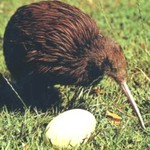 New Zealand's (Aotearoa) national bird is the kiwi and the people call themselves kiwis – yet New Zealand’s state-owned coal mining company plans to destroy prime habitat of the endangered great spotted kiwi with a new open pit coal mine.
New Zealand's (Aotearoa) national bird is the kiwi and the people call themselves kiwis – yet New Zealand’s state-owned coal mining company plans to destroy prime habitat of the endangered great spotted kiwi with a new open pit coal mine. The Cypress Opencast Mine is planned by Solid Energy on the West Coast of NZ's South Island – in an area called "Happy Valley". The high quality coal is used to make steel, with most being exported to Japan, to companies including Nippon Steel and Mitsubishi Chemical Corporation.
Solid Energy claims it can kill kiwi under the Coal Mines Act despite the species being "absolutely protected" under the Wildlife Act. As well as being prime habitat for the great spotted kiwi, the proposed coal field is home to a rare land snail, rare red tussock grasslands, wetlands, and beech forest derived from the ancient supercontinent Gondwana. Two open pit mines, disposal areas and roads and offices will scar some 250 hectares of this distinctive landscape, while fouling natural waterways.  Strangely, the New Zealand government is funding both kiwi restoration projects throughout the country to save them from extinction, while simultaneously promoting coal mining which is destroying prime kiwi habitat. A broad coalition of environmental groups is fighting the mine. Earlier this year local NGOs and a Maori tribe took Solid Energy to court in order to stop the mine. Solid Energy won but is now suing two of the NGOs for costs totaling $US270,000.
Strangely, the New Zealand government is funding both kiwi restoration projects throughout the country to save them from extinction, while simultaneously promoting coal mining which is destroying prime kiwi habitat. A broad coalition of environmental groups is fighting the mine. Earlier this year local NGOs and a Maori tribe took Solid Energy to court in order to stop the mine. Solid Energy won but is now suing two of the NGOs for costs totaling $US270,000.
, The proposed Cypress mine highlights the huge environmental costs of coal mining. The habitat of endangered species found only in New Zealand is to be mined to provide coal to Japanese steel mills that tremendously exacerbate climate change. Please take the time to demand that Nippon Steel and Mitsubishi Chemical not buy coal derived from the habitat of New Zealand's endangered national bird.
The Kiwi The "kiwi" is a flightless New Zealand bird. (New Zealanders also like to call themselves "Kiwis".) The kiwi (bird) is unusual in at least two respects. First, it is the only bird in the world that has its nostrils at the end of its beak. Second, the female kiwi has the largest egg, in proportion to its body size, of any bird in the world (except possibly for the hummingbird). Kiwi are about the same size as chickens, but their eggs are almost as big as those of ostriches! Kiwi birds have been designated as New Zealand "honorary mammals". The only real native mammals in New Zealand are two kinds of forest-dwelling bats. Biologists and the like please note: the kiwi is a member of the order Apterygiformes and comes in six species, including (Apteryx mantelli, Apteryx australis, Apteryx oweni, and Recent research seems to indicate that the kiwi evolved after New Zealand broke away from the ancient Australia/Antarctica supercontinent. However, kiwi left Australia for New Zealand at some point, possibly on land links via New Caledonia. So, although there are no wild kiwi left there, Australians may also proudly point to the kiwi as "their bird". The kiwi bird's name comes from the Maori language, and imitates the cry of the male kiwi during the mating season. The first European settlers to encounter the kiwi very sensibly used the Maori name, which is probably thousands of years old, rather than trying to rename the bird.
The "kiwi" is a flightless New Zealand bird. (New Zealanders also like to call themselves "Kiwis".) The kiwi (bird) is unusual in at least two respects. First, it is the only bird in the world that has its nostrils at the end of its beak. Second, the female kiwi has the largest egg, in proportion to its body size, of any bird in the world (except possibly for the hummingbird). Kiwi are about the same size as chickens, but their eggs are almost as big as those of ostriches! Kiwi birds have been designated as New Zealand "honorary mammals". The only real native mammals in New Zealand are two kinds of forest-dwelling bats. Biologists and the like please note: the kiwi is a member of the order Apterygiformes and comes in six species, including (Apteryx mantelli, Apteryx australis, Apteryx oweni, and Recent research seems to indicate that the kiwi evolved after New Zealand broke away from the ancient Australia/Antarctica supercontinent. However, kiwi left Australia for New Zealand at some point, possibly on land links via New Caledonia. So, although there are no wild kiwi left there, Australians may also proudly point to the kiwi as "their bird". The kiwi bird's name comes from the Maori language, and imitates the cry of the male kiwi during the mating season. The first European settlers to encounter the kiwi very sensibly used the Maori name, which is probably thousands of years old, rather than trying to rename the bird.



